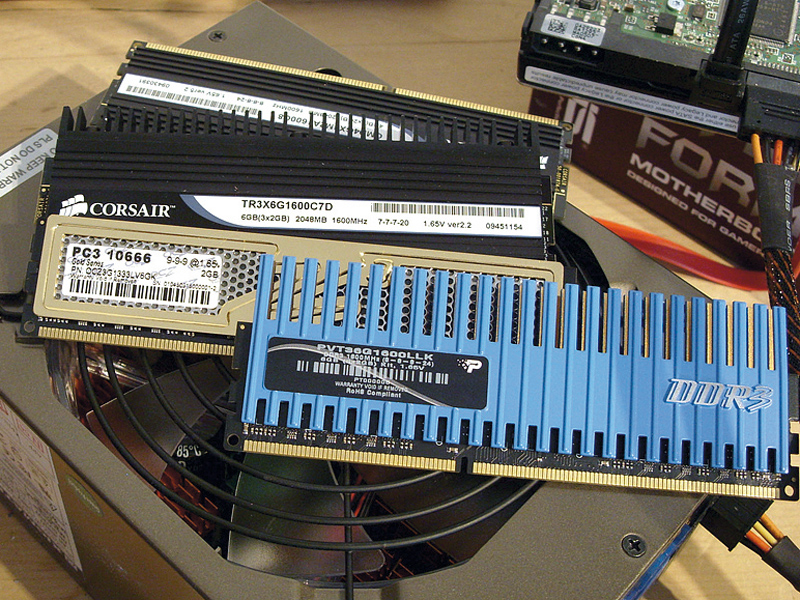
Processors and graphics cards get all the glory, but then they're always the glitzy A-list stars that grace the covers of all the magazines. But the sad truth is there's simply less glory in overclocking memory.
The gains aren't as tangible and that feeling of getting something for nothing isn't as great, as you've probably forked out for expensive overclocking memory.
Cynicism aside, the fact you can overclock your memory means you should. But before diving in head first it's always best to peer into the murky waters and see what you can learn.
Hopefully, you know that memory runs at a set clock speed and increasing this is our first tool in faster memory.
While we mention it, if you're wondering where the often used PCxxx measure used with memory comes from, it's simply eight times the clock speed. This is the theoretical throughput calculated as the clock speed, and times the number of bits (64) divided by eight to get a bytes value.
The second area of mystery is the memory timing figures that often go 8-8-8-24 possibly with a T1 or T2. These describe the amount of time memory requires to perform certain actions. They are always listed in this order and are measured in clocks:
CAS Latency (CL)
Get daily insight, inspiration and deals in your inbox
Sign up for breaking news, reviews, opinion, top tech deals, and more.
The amount of time between the processor asking for data and the memory starting to return it.
RAS to CAS delay (tRCD)
How long it takes to activate a specific RAS line and the subsequent CAS column in memory.
RAS precharge (tRP)
How long it takes to disable an active RAS line and activate the next one.
Active to precharge delay (tRAS)
The amount of time required between memory accesses.
Command rate (CMD)
Either T1 or T2 indicating one or two clock cycles and is the time between the memory being activated and when the first command can be sent.
In reality there's little you can do with the majority of these settings and you'll find you gain little if you try reducing the settings.
The best results come from reducing the CAS latency which you'll find will release a few per cent of extra performance, as you can see from our results. The alternative way comes from increasing the clock speed, as this simply increase the throughput of the memory. The balancing act comes with the fact latency increases to keep timings under control.
One thing we've not mentioned are the default SPD settings held within memory modules. When your PC posts it'll scan the memory modules for the SPD settings, these hold the default timings for the modules at specific clock speeds.
Over recent years both Nvidia and Intel have released their own extensions to these in the form of EPP/SLI-ready and XMP respectively. These offer a way for memory manufacturers to sell overclocking memory and for systems to automatically take advantage of these in a stable manner.
Volting again
As with the processor, once you start increasing the clock speed this extra burden on the memory can require increased voltages as power requirements go up.
The stock voltage with DDR3 is 1.5 volts. As guidance the maximum JEDEC recommended voltage is 1.575 and supposedly modules should be able to handle 1.975 volts without permanent damage, though they don't have to function at this level.
Most overclocking memory requires a 1.65 voltage and in reality there's no reason to go above 1.85 volts, while for general use 1.7 volts is a safe maximum.
Once again for the actual overclocking there are three options. The BIOS is the most hit and miss, the options made available to you can vary wildly from board to board, but you're usually presented with at least the ability to control the memory's clock speed, the timings we've already mentioned and the base voltages.
To measure just the performance of the memory overclock we're going to maintain the CPU speed as close to its stock 3.2GHz as possible. We can do that by knocking down the multiplier as we increase the FSB.
We'll start by reducing the CAS latency at stock speeds to see how much of an increase that can return, before increasing the clock speeds. This will increase bandwidth but also latency, so the balancing act will be to see which one pays the most dividends.
We're not using specific overclocking memory, just solid 1,600MHz 8-8-8-24 memory, so it's more in line with what most people will have in their rigs.
- 1
- 2
Current page: Overclock DDR3 memory: what's the advantage?
Next Page Overclock DDR3 memory: step-by-step